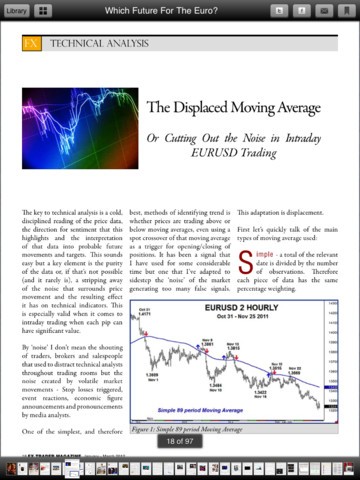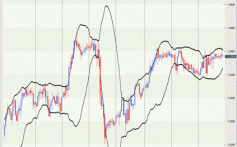FX Trader Magazine
Post on: 16 Март, 2015 No Comment

The Art of the Chart: Ichimoku Kinko Hyo
Ichimoku Kinko Hyo is a multifunctional visual trend following charting system. It has been described as the king of indicators and trading or analyzing with it is a kind of high-level art. Using Ichimoku, it is possible to get the whole picture of the market, including trend direction, the main support/resistance levels, and exact entry or exit points. Furthermore it helps to define the strength of a signal. The system can be used successfully for all markets and on all time frames, but like most indicators — it performs a bit better on the higher ones. In this first article we will explain the basics of analyzing with the Ichimoku Kinko Hyo charting system and introduce it in a nutshell. The aim is to give a basic knowledge enabling anyone to understand an Ichimoku report or analysis.
Ichimoku Kinko Hyo was developed by a Japanese economic journalist, named Goichi Hosoda, whose aim was to create a kind of all-in-one indicator, allowing deeper analysis of charts, in a shorter time. The development of the system was a huge and complex work, as there was no possibility for doing automated back tests at that time. Goichi Hosoda started the process before the Second World War, with a large group of hired students, who had to manually backtest the different calculated formulas. Finally, after more than twenty years of testing and chiseling, Hosoda presented the Ichimoku Kinko Hyo charting system in his book in 1969, and it rapidly became the most frequently used indicator in Japanese trading rooms.
In spite of being popular in Japan, unfortunately it is a kind of over-mystified, exotic, and still nearly unknown chart analyzing technique in the Western world. The reason of the Western traders abstinence could be explained using some cross-cultural studies. It is proven, that Japanese people usually consider and perceive the whole picture, while Westerners usually pick the main components and concentrate only on those. Since Ichimoku is really a kind of whole picture system, it could be challenging to learn and use it properly, and the fact that Japanese are not interested in sharing their knowledge with the Western world (inasmuch as among many others — the original Ichimoku books and materials have never been translated into English) doesnt make the whole thing easier. Although the appearance of the Ichimoku Kinko Hyo system may look a bit complicated at first sight, it is doubtless that learning it is very worthwhile.
To be able to analyze (or understand an analysis) with Ichimoku Kinko Hyo, the first thing to acquire is its basic terminology. In the term, Ichimoku Kinko Hyo, Ichimoku means: one glance, Kinko means: equilibrium or balance, and Hyo means: chart. So it could be translated as: One glance equilibrium chart, or Chart balance at a glance. The name brings out the essence of the system well. However Ichimoku consists of five separated lines and it is necessary to use the components together to see the whole picture — the equilibrium or the disequilibrium of the market — at a glance. There is no point about using the lines separately. While doing chart analysis the components have to be compared with each other and with the price too.
The lines of the Ichimoku Kinko Hyo are the following:
- Tenkan-sen (Conversion line) is calculated as (Highest High + Lowest Low)/2 for the past 9 periods. It represents the strength of the momentum and generates a signal if it crosses up (bullish sign) or down (bearish sign) Kijun-sen.
- Kijun-sen (Standard line) is calculated as (Highest High + Lowest Low)/2 for the past 26 periods. It can behave as a strong support or resistance line and as a key line in predicting trend changes, it is less sensitive to minor price movements.
- Chikou Span (Lagging Span) is calculated as current price time-shifted backwards 26 periods. It is a very special component of the system, and can be used in many ways. The most common technique is to observe if Chikou Span is above (bullish sign) or below (bearish sign) the price.
- Senkou Span A (Faster Span A) is calculated as (Tenkan-sen + Kijun-sen)/2. It forms the unique and spectacular Kumo (Cloud) feature of Ichimoku with Senkou Span B, and represents the possible support and resistance levels of the future.
- Senkou Span B (Faster Span B) is calculated as (Highest High + Lowest Low)/2. As I mentioned previously, it forms the Kumo with Senkou Span A, and represents main support and resistance levels of the future.
The standard settings for the Ichimoku Kinko Hyo indicator are: 9-26-52. The base number of the formula is 26. The common view is that the number 26 represents a standard Japanese business month (including Saturdays), the number 9 represents a week and a half, and the number 52 represents two months. Some hold different views and say that the calculation of Goichi Hosoda is based on — among others — Moon cycles, as the number 26 is the best approximate number to express a full Moon cycle, the number 9 represents one and a half quarter of a Moon cycle, and the number 52 represents a double Moon cycle. Anyway, the system works best with these numbers, however it is possible to use alternative values too.
When creating an analysis with Ichimoku, it is strongly recommended to always start from the higher time frames and proceed with lower time frames successively. It is easy to notice that Ichimokus components of the higher time frames have an effect on the lower time frames. For example, it is common that the Daily charts Kijun-sens value is the exact value of the 4 hours Senkou Span A or B (the top or the bottom of the Kumo).
The following details should always be determined in a Ichimoku Kinko Hyo analysis:
1.The position of the price versus Kumo
The fundamental of trend determination is: if price is above Kumo the overall trend is bullish, if it is below Kumo, the overall trend is bearish. The Kumo itself is a kind of no mans land, as it is not recommended to trade, when the price is moving in the Cloud. The top and bottom of the Kumo (the Senkou Span A and B lines) are very strong support and resistance lines. If the price is above the Kumo, the top line of it acts as a first support, and the bottom line acts as a second support. When the price is below the Kumo, the bottom line of the cloud is the first resistance, and the top of the Cloud is the second resistance line. The thickness of the Kumo is very important too, as it is more difficult for the price to break through a thick cloud, than a thin cloud.
2. Tenkan-sen versus Kijun-sen
The fact that Tenkan-sen is below Kijun-sen supports a bearish move, the opposite of it indicates a bullish move. It is always recommended to check the position of the price versus Tenkan-sen and Kijun-sen too. If the price moves quickly and leaves behind Kijun-sen, it usually turns flat, and, in order to dissolve the disequilibrium, it attracts the price back. Then, they both continue the movement together.
3. Chikou Span versus price and Kumo
If Chikou Span is above the price, the trend is bullish. If it is below the price, the trend is bearish. If Chikou Span is above the Kumo, it supports the bullish movements. If it is below the Cloud, the bearish movements are supported. Chikou Span is a great tool to filter the signals generated by the other components.
4. The color of the Kumo future
It confirms that the trend is tending to be bullish or bearish. Light Kumo indicates a possible uptrend, a dark Kumo indicates a possible downtrend. The Kumo twist, when Senkou-Span A crosses Senkou-Span B and the color of the Kumo changes, indicates a possible change in the trend.
After getting an overall picture at a glance, the next step is to look for exact entry opportunities using some of the available Ichimoku trading strategies or methods. The basic methods are: Tenkan-sen/Kijun-sen cross, Kumo breakout, Chikou Span/Price cross. The advanced methods are based on the basic ones, with some modification or with a combination of other tools (for example Pivot points or index charts).
A. Tenkan-sen/Kijun-sen cross
This is the most well-known Ichimoku trading method. If the Tenkan-sen crosses up the Kijun-sen, that is a buy signal. If it crosses down Kijun-sen, that is a sell signal. Looking at the previously mentioned analysis steps, if the price is above the Kumo (for a long signal), the signal is strong. If the cross happens in the Cloud, the signal is neutral. Finally if it happens below the Kumo, the long signal is weak. The Chikou Span should at least be above the price (for a strong signal — naturally — it should be above the Kumo too), and the Kumo future should support the move too. For a sell signal, the opposite applies.
B. Kumo breakout
If the price enters into the Cloud and then breaks out from it, that is a Kumo breakout. Chikou Span should be on the right side of the price, and it should break out and close outside the Kumo as well. The Kumo future also has to support the direction. It is a frequent happening that, although price breaks out from the Cloud, Chikou Span bounces back from the top (or bottom) line of it, and then the price moves back into the Cloud too. This happening is only a fake breakout, so it is always recommended to check every line of the Ichimoku system, and enter into a position only if all the components point in the same direction and support the move.
C. Chikou Span/Price cross
If Chikou Span crosses up the price, that is a buy signal. If it crosses down the price, that is a sell sign. The Kumo determines the strength of the signal here too. A buy signal can happen above the Kumo (strong), in the Kumo (neutral) and below the Kumo (weak). For a sell sign, the opposite applies here too.
For stop-loss, it is possible to use various techniques, for example the other side of the Kumo (+buffer), the last high/low or the last round number. Many Ichimoku traders move their stop with the Kijun-sen line (+buffer) as a trailing stop. The same applies to the take profit methods.
After this theoretical summary of the Ichimoku Kinko Hyo charting system, the most important thing is to put this knowledge into practice. From the next issue of FX Trader Magazine we will start publishing practical chart analyses and sharing some of the less known advanced Ichimoku techniques.














